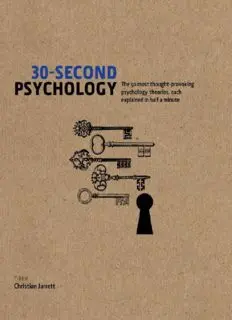
30-Second Psychology : the 50 Most Thought-provoking Psychology Theories, Each Explained in Half a Minute PDF
Preview 30-Second Psychology : the 50 Most Thought-provoking Psychology Theories, Each Explained in Half a Minute
30- SECOND PSYCHOLOGY The 50 most thought-provoking psychology theories, each explained in half a minute Editor Christian Jarrett Contributors Vaughan Bell Moheb Costandi Christian Jarrett Dave Munger Tom Stafford First published in the UK in 2011 by Icon Books Ltd Omnibus Business Centre 39–41 North Road, London N7 9DP email: [email protected] www.iconbooks.co.uk © 2011 by Ivy Press Limited The editor and contributors have asserted their moral rights. No part of this book may be reproduced in any form, or by any means, without prior permission in writing from the publisher. This book was conceived, designed and produced by Ivy Press 210 High Street, Lewes East Sussex, BN7 2NS, UK www.ivypress.co.uk Creative Director Peter Bridgewater Publisher Jason Hook Editorial Director Caroline Earle Art Director Michael Whitehead Designer Ginny Zeal Concept Design Linda Becker Illustrator Ivan Hissey Profiles & Glossaries Text Nic Compton Assistant Editor Jamie Pumfrey Digital Assistant Emily Owen Digital ISBN:9781848314511 Colour origination by Ivy Press Reprographics CONTENTS Introduction Old School, New School GLOSSARY Wundt’s introspection Watson’s behaviourism Psychoanalysis profile: Sigmund Freud The cognitive revolution Evolutionary psychology Positive psychology Growth & Change GLOSSARY Piaget’s stages Vygotsky’s zone Birth order profile: Jean Piaget Harlow’s monkeys Kohlberg’s moral stages Neuroplasticity Decision Making & Emotions GLOSSARY Ekman’s universal emotions Festinger’s boring task James–Lange theory of emotion profile: William James Damasio’s emotional decision making Wason’s confirmation bias Baumeister’s ego depletion Kahneman & Tversky’s prospect theory Social Psychology GLOSSARY The bystander effect Janis’ groupthink Allport’s contact hypothesis Zimbardo’s prison profile: Stanley Milgram Milgram’s obedience study Stereotype threat Follow the leader Ways We Differ GLOSSARY The Lake Wobegon effect The big five Fundamental attribution error profile: Hans Eysenck Nature via nurture The Flynn effect Ericsson’s 10,000-hour rule Nominative determinism Disordered Minds GLOSSARY Sperry’s split brains Seligman’s prepared learning Charcot’s hysteria Rosenhan’s insane places profile: Aaron Beck Kapur’s aberrant salience Maslow’s humanistic psychology Beck’s cognitive therapy Extreme male brains Thoughts & Language GLOSSARY The placebo effect Pavlov’s dogs Sapir–Whorf hypothesis Chomsky’s universal grammar Loftus’ false memories profile: Elizabeth Loftus Embodied cognition Broadbent’s bottleneck Miller’s seven Consciousness APPENDICES Resources Notes on contributors Index Acknowledgments INTRODUCTION Christian Jarrett The familiarity of psychology’s subject matter sets it apart from the other sciences. After school, few of us will set foot in a chemistry laboratory, we’re unlikely to peer down a microscope and the closest that we’ll get to a black hole is watching Star Trek. By contrast, we all have a mind of our own, and we spend every day interacting with others. So the focus of psychology – on minds and behaviour – is familiar to everyone. In a sense, we’re all amateur psychologists. However, we should be careful not to confuse familiarity with mastery. Just because we have our pet theories for other people’s motives and actions, doesn’t mean they are accurate. Psychology is about setting aside our intuitions and using the objective tools of science to discover how the mind really works, why people really behave the way they do. Such an endeavour met resistance from the outset. Questions of the mind used to be the preserve of philosophy. And even after the first laboratories demonstrated the feasibility of a psychological science, a movement within the discipline argued that only observable behaviour, not inner thoughts, should be studied. The first section of this book, Old School, New School, charts how these arguments were resolved and how psychology became the thriving and respected science that it is today. A topic that provokes particularly strident lay beliefs is that of child development. Just how does a screaming, helpless, newborn child mature into a fully formed, self-conscious adult? The section on Growth & Change introduces you to the pioneers in this field and concludes with the theory of neuroplasticity – recognition that our brains are flexible and never stop changing and adapting until the day that we die. The mind turned inward Psychology is the scientific study of ourselves and why we behave the way we do. Intuition is put on hold and cool-headed experimentation is the order of the day. A focus of psychology that is of extreme practical relevance is how to optimize the decisions people make for the good of themselves and society at large. Decision Making & Emotions provides an overview of some of the biases that affect our thinking. As you will see, emotions, as well as providing the foundation of our humanity, also influence our decisions and so the two topics are dealt with together. Whether in gangs or companies, sports teams or political parties, we humans are intrinsically social, forever forming groups to serve our needs and interests. Social Psychology deals with the issues that naturally arise when we mix and merge, including leadership and prejudice. The chapter also features some of the most famous experiments in psychology including Zimbardo’s insights into tyranny and Milgram’s ‘shocking’ research on obedience. The next two sections, Ways We Differ and Disordered Minds, feature theories that perhaps most closely resemble popular beliefs about psychology: from personality and intelligence to insanity and psychotherapy. The last section, Thoughts & Language, deals with those theories that delve inside our heads, beginning with the placebo effect—the power of the mind to affect the body – and ending with consciousness, the miracle and mystery of how flesh gives rise to mental life. Each of the book’s 50 entries provides a plain English 30-second introduction, a 3-second ‘psyche’ for when you’re really in a rush, and a 3-minute analysis, which probes a little deeper. The chapters also include biographical profiles of some of the luminaries in this field, including Sigmund Freud and William James. Whether you choose to dip in or to study the book from cover to cover, you are about to learn about the most complex entity in the universe – the human mind. Have fun!
